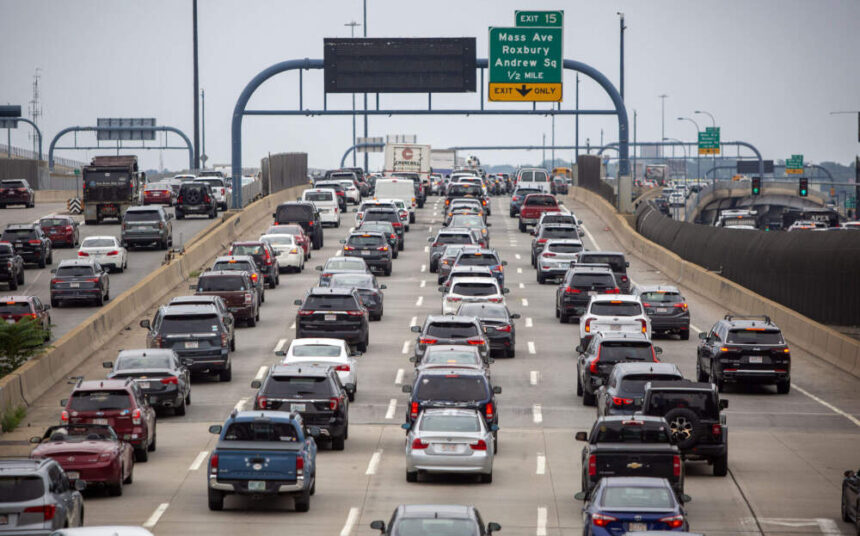It’s about to get more expensive to drive into the heart of Manhattan, and some transportation experts in Boston are watching closely.
Beginning June 30, New York City plans to charge drivers entering a portion of lower Manhattan up to $15. The policy is designed to ease gridlock on the island’s famous streets and avenues. It’s also projected to bring in about $1 billion a year to help fund the city’s public transportation system.
Called “congestion pricing,” the Manhattan tolling system works by treating roads as a good or a product where demand impacts the price. During peak drive times, when the demand to enter the targeted area is higher, the price goes up. Overnight, the price is lower. There are some discounts and exemptions, including for vehicles transporting people with disabilities. A few other major cities, including London and Singapore, already use some form of congestion pricing.
“The idea of congestion pricing flows directly from an understanding that the root cause of congestion is that the roads are underpriced,” said Michael Manville, a professor at the University of California, Los Angeles Luskin School of Public Affairs whose research focuses on transportation. Manville describes congestion pricing as a tool to make roads “work better” by encouraging drivers to pursue other routes or public transit, thus reducing gridlock and getting people where they need to go faster.
Boston, with its financially troubled transit system and notorious traffic, could be a good candidate for a similar program, Manville said. Adding tolls on highways leading to downtown Boston “really has the potential to be hugely efficiency enhancing,” he said, “removing congestion while simultaneously letting the road carry more cars” because traffic moves faster.
Boston ranks within the top five worst cities in the world for traffic — just ahead of New York City — according to mobility tracker INRIX. Reggie Ramos, the executive director of the advocacy group Transportation for Massachusetts said “anyone who’s ever been in a car and stuck in traffic in Boston” or “anybody who has never had any bus transit service because they do not have it in their area” is ready to consider congestion pricing.
State Sen. Brendan Crighton, co-chair of the Legislature’s joint committee on transportation, said congestion pricing could help manage traffic and raise funds for the state’s transportation needs.
“We should flush out this idea a bit more and see what it looks like on a ground level,” he said.
The MBTA needs nearly $25 billion to bring the transit system into a state of good repair, according to the agency’s estimates, and “we’re trying to dive into a bit more how much it would be for all of our roads and sidewalks and bridges,” Crighton said. “We have a crisis here.”
The effort to bring congestion pricing to New York City took nearly a decade and spawned at least three lawsuits. Opponents argue the tolls amount to an unfair tax on drivers, and will worsen traffic and pollution in neighborhoods that are not subject to the fees. Concerns have also been raised about the program’s potential effect on parking, and on commuters from areas that lack public transportation.
It’s unclear how much appetite there is in Massachusetts to tap drivers for more transportation funding.
Earlier this year, Gov. Maura Healey put together a task force to recommend new revenue sources for transportation. But she quickly shut down an idea pitched by the task force’s chair, state Transportation Secretary Monica Tibbits-Nutt, to add tolls at the state’s borders.
“I am focused on affordability, I am focused on competitiveness,” Healey said during an appearance on WBUR’s Radio Boston. “I’m not putting tolls at the border.”
Healey’s comments were discouraging for some transit advocates. Brian Kane, who leads the MBTA Advisory Board and serves on the transportation funding task force, said no idea should be off the table.
“We shouldn’t be afraid to have conversations about things and weigh the pros and the cons,” he said. “But, you know, [tolls have] been removed, so, you know, that’s one of the reasons why I don’t think we will see congestion charging in the next five years — at least five years.”
Crighton, who also serves on the state transportation funding task force, said he’ll monitor New York City’s roll out of congestion pricing, “but it’s not going to necessarily, you know, move us in one direction or another.”
“Certainly [it] could inform us as how viable of an option could congestion pricing be,” he said, “as compared to some of the other options we’re looking at.”
This segment aired on May 23, 2024.











